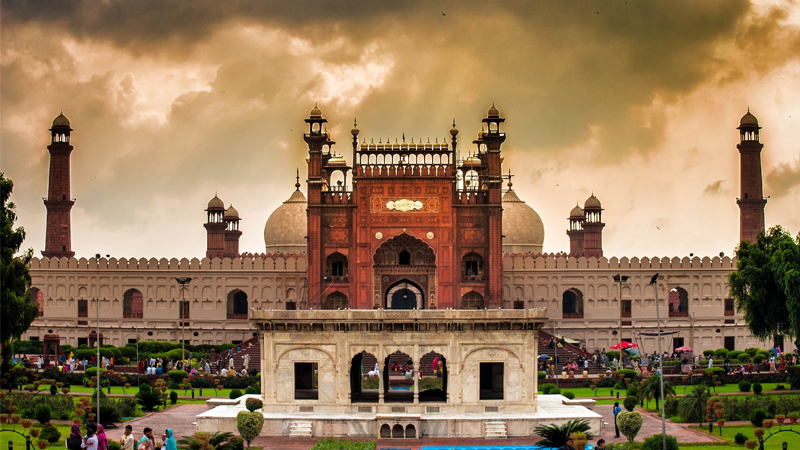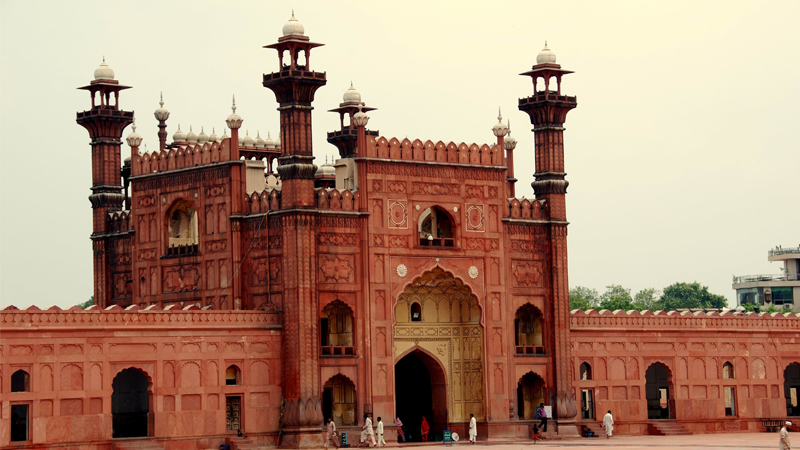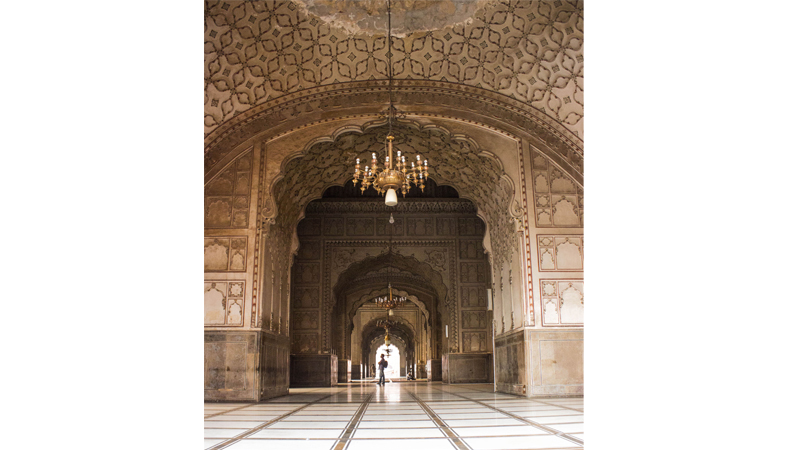 Let me take you to a known mosque of Lahore – the Badshahi Mosque which can be rightly said as the ‘King of all Mosques’ in Lahore. Every time you will visit this mosque it will mesmerise you with its exquisiteness and everlasting grandeur and I must say that it is a matchless mosque and remained the world’s largest mosque for almost 313 years in history. For the first 70 years after its construction in 1673, the mosque was known simply for its great size, and was visible from almost 10 miles away. Now you can imagine the value, importance and splendor of the mosque!
Let me take you to a known mosque of Lahore – the Badshahi Mosque which can be rightly said as the ‘King of all Mosques’ in Lahore. Every time you will visit this mosque it will mesmerise you with its exquisiteness and everlasting grandeur and I must say that it is a matchless mosque and remained the world’s largest mosque for almost 313 years in history. For the first 70 years after its construction in 1673, the mosque was known simply for its great size, and was visible from almost 10 miles away. Now you can imagine the value, importance and splendor of the mosque!
The mosque is said to be constructed between 1671 and 1673, under the supervision of Fida’i Khan Koka who was Mughal Emperor Aurangzeb’s brother-in-law and the governor of Lahore. After only two years of construction, the mosque was opened in 1673. Badshahi Mosque’s splendor is influenced by the Jamia Mosque of Delhi which was built by Mughal Emperor Shah Jahan. Since the north end of the mosque was built along the edge of the Ravi river, it was not possible to install a north gate like the one used in the Jamia Mosque, and a south gate was also not constructed in order to maintain the overall symmetry.
Now let us come to a question, that why was this mosque constructed here? Historic references tell us that the Badshahi Mosque was initially planned to guard a strand of the last Prophet’s (PBHU) hair. I am sure many of didn’t know this fact. Other historic accounts tell that Aurangzeb built the mosque in order to commemorate his military campaigns against the Maratha king Chhatrapati Shivaji.
The exterior of the mosque is decorated with strong stone carving and marble inlay on red sandstone, which make the mosque look different from all other Mughal era mosques. This is why it is known as the ‘king of mosques’
Another interesting thing about this mosque is that it was the reason that changed the river Ravi’s bed. Badshahi mosque was constructed just a few hundred meters to the west of Lahore Fort and at that time River Ravi was flowing nearby. The mosque was built on a high raised platform to avoid any floods during that time. At the time of its construction, historic references tell that, Mughal Emperor Alamgir Aurangzeb ordered to place barriers at one point in the river so that the water does not flow close to the mosque and the mosque doesn’t get damaged. So with the passage of time, due the barriers inside the river, the river changed its bed and now we see River Ravi flowing far away. Aurangzeb also added the Alamgiri Gate facing the Mosque and the space in between, a garden was constructed, which was used as a parade ground where the Emperor would deal with his army and troops. Today the same garden is known as Huzoori Bagh which was named by Maharaja Ranjeet Singh.
This mosque and the garden of Huzoori Bagh are one of its kinds in the world as they house the monuments of all the eras. The Alamgiri Gate of Lahore Fort, Huzoori Bagh Baradar, Samadhi of Maharaja Ranjit Singh, and Mughal era original Roshnai Gate, Tomb of Allama Iqbal, British era Roshnai Gate and tomb of Sir Sikandar Hayat Khan. Besides being a mosque, the Badshahi Mosque is a famous tourist spot for the people and almost thousands of tourists visit it every day and on weekends it is over flowing with tourists from all over Pakistan. All the state guests and important dignitaries are also taken to a tour of this majestic mosque located in the heart of Lahore, the walled city of Lahore. It is one of the remains we treasure today as anybody visiting the place can experience the entire history of this region through the monuments located near this mosque. Another interesting aspect is that the Samadhi of Maharaja Ranjit Singh is also close to the mosque thus showcasing the best example of religious harmony.
Now let us go inside the mosque. From the Greater Iqbal Park, crossing the Samadhi and fort’s postern gate you will enter into the Huzoori Bagh and on your right hand stands the majestic mosque known as the best example of Mughal architecture. Huge three-sided marble steps that lead to the magnificent gate of the Mosque. Entering the gate you will see the vast courtyard with a fountain in the center.
 The interior of the mosque has rich ornamentation in stucco tracery and paneling with fresco motifs and marble inlay. Within the courtyard, the prayer hall features four minarets that duplicate the four minarets at each corner of the Mosque’s outskirts. The entire architecture is a mark of symmetry which was known in Mughal architecture. We see that the main prayer hall is divided into seven parts by means of multi-foiled arches supported on heavy pillars, three of which bear the white marble double domes whereas the other four parts are covered with flat domes. In an effort to mirror the character of its founder, architects designed the mosque to exude boldness, vastness and majesty. The walls had been built with small kiln-burnt bricks laid in kankar, lime mortar but have a finishing of red sandstone. The steps leading to the prayer chamber and its plinth have been constructed with variegated marble. The dalans or chambers on the sides of the mosque have a unique echo system and you need to visit the mosque with a guide to experience that.
The interior of the mosque has rich ornamentation in stucco tracery and paneling with fresco motifs and marble inlay. Within the courtyard, the prayer hall features four minarets that duplicate the four minarets at each corner of the Mosque’s outskirts. The entire architecture is a mark of symmetry which was known in Mughal architecture. We see that the main prayer hall is divided into seven parts by means of multi-foiled arches supported on heavy pillars, three of which bear the white marble double domes whereas the other four parts are covered with flat domes. In an effort to mirror the character of its founder, architects designed the mosque to exude boldness, vastness and majesty. The walls had been built with small kiln-burnt bricks laid in kankar, lime mortar but have a finishing of red sandstone. The steps leading to the prayer chamber and its plinth have been constructed with variegated marble. The dalans or chambers on the sides of the mosque have a unique echo system and you need to visit the mosque with a guide to experience that.
We get to know from the architects and historic references that the original floor of the mosque’s courtyard was laid with small kiln-burnt bricks laid in the Mussalah pattern (prayer rugs pattern). Somewhere during the repairs in 1939-60 the red sandstone flooring was re-laid which we see now. The original floor of the prayer chamber was also replaced by marble Mussalah during the same repairs. There are only two inscriptions in the mosque: one on the gateway and another of Kalmah in the prayer chamber under the main high vault. The ceilings and walls are beautifully embellished.
If we talk about the exterior of the mosque it is decorated with strong stone carving and marble inlay on red sandstone, which makes the mosque look different from all other Mughal era mosques, which is why it is known as the ‘king of mosques’. The exterior of the Mosque represents grandeur and dignity of the mosque. On the exterior you will observe the lotus motifs in bold relief. These are also replicated in other parts of the mosque. Architects claim that the embellishment of the mosque has Indo-Greek, Central Asian and Indian architectural influences both in techniques and decorative motifs. Beautiful ornamental merlons, inlaid with marble lining, add grace to the perimeter of the mosque and beautify the skyline. The notable features of the mosque are the vast square courtyard, the side aisles (dalans), the four corner minarets, the projecting central transept of the prayer chamber, and the grand entrance gate. The mosque has the capacity of accommodating 55,000 worshippers, and I guess it’s a huge number. There is also a museum inside the mosque where you can see amazing relics of the past and Islamic history.
 Like many other mosques of Lahore, this mosque could not escape the victimisation of the rules after the fall of Mughal Empire either. During the rule of Maharaja Ranjeet Singh, the Hujras (rooms) around the outer boundary of the mosque were occupied by his army troops. Ranjit Singh himself used Huzoori Bagh as his official Royal Court and constructed the Baradari. Some years later, a moderate earthquake struck Lahore and collapsed the marble towers at the top of each minaret. The open towers served as a position for large weaponry during the Sikh civil war.
Like many other mosques of Lahore, this mosque could not escape the victimisation of the rules after the fall of Mughal Empire either. During the rule of Maharaja Ranjeet Singh, the Hujras (rooms) around the outer boundary of the mosque were occupied by his army troops. Ranjit Singh himself used Huzoori Bagh as his official Royal Court and constructed the Baradari. Some years later, a moderate earthquake struck Lahore and collapsed the marble towers at the top of each minaret. The open towers served as a position for large weaponry during the Sikh civil war.
Then came the British rule and the mosque was turned into military garrison. The Mosque was much damaged during the Sikh eras and therefore in 1852 the British established the Badshahi Mosque Authority for the restoration of the mosque so that it could be returned to Muslims as a place of worship. In 1939 massive repairs began under the supervision of architect Nawab Zen Yar Jang Bahadur. The repairs continued until 1960 and were completed at a cost of 4.8 million rupees.
Now if you want to experience the view of this great mosque you can also see it from the roof tops of the restaurants of the fort road food street. The mosque is also illuminated at night and tourists are being taken there, which is a new addition in the tourism of Lahore. I think the mosque should be listed as a world heritage site too like Lahore Fort.
Published in Daily Times, July 28th 2018.